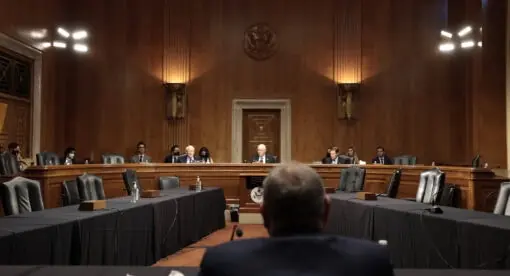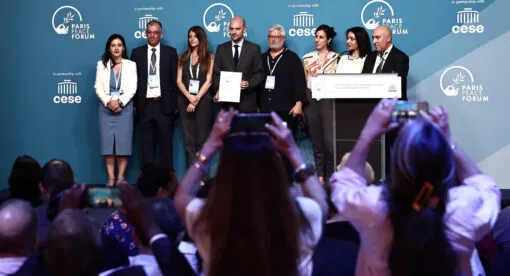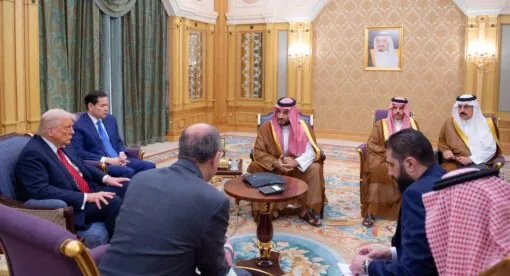In this episode of “Roamings and Reflections,” Mercy Corps Senior Policy Advisor Yasmin Faruki joins host Alice Hickson to share what she’s learned from her travels to Yemen and her work directing humanitarian policy efforts there. Faruki discusses obstacles to humanitarian work in Yemen and speaks candidly about the need to partner with local organizations to create a sustainable future.
Alice Hickson: Hello, and welcome to a new episode of the Roaming and Reflection Series within the Newlines Institute for Strategy and Policy Contour Podcast. This series highlights recent trips to the field, domestic and foreign, made by Newlines staff members, government officials, and humanitarian practitioners, drawing out their timely, relevant, and actionable field findings that are of great relevance to policy and geopolitics.
For this episode, I will be joined by Yasmin Faruki, a senior policy advisor at Mercy Corps, an international humanitarian, development, and peace-building NGO present in over 40 countries. She previously served as Mercy Corps’ lead due diligence specialist for the humanitarian response inside Syria and worked with the U.N. Development Programme in Jordan. Yasmin recently returned from a trip to Yemen, where Mercy Corps has been operating since 2010 to provide urgent lifesaving assistance while also working to address longer-term needs. Welcome, Yasmin.
Yasmin Faruki: Thanks for having me.
AH: So walk us through your recent trip to Yemen. Why were you there? What did you see and experience?
YF: Absolutely. So I had the pleasure of visiting Yemen during the second half of March, and my primary goal was to gain a better understanding of the context and our programming. I had the opportunity to visit the southern part of the country, specifically in Aden and Taiz.
Aden is the capital for the internationally recognized government and sits along the Red Sea, the Arabian Sea, and the coast, and Taiz is known as one of the besieged cities in Yemen that’s split currently between the internationally recognized government and a rival authority known as Ansar Allah, or the Houthis, and Mercy Corps’ operation on both sides there.
In terms of what I saw and what I experienced, I can say that for the first time in my career working on humanitarian assistance and having been in the Middle East, I witnessed suffering up close. By suffering, I mean the inability of people to provide for themselves due to factors completely beyond their control.
What I saw were men cutting wood on the side of the road because they couldn’t afford fuel, women having to split flour among six or seven kids in a household to make basic ends meet, no soap or functioning toilets in several parts of the country, and I think more importantly what I left with from the trip was just a deep sense of humility and recognition of the loss of dignity and trauma that so many Yemenis have experienced.
In one example, I remember walking downtown in Aden to go towards a local fish market with some colleagues, and I noticed a number of posters of people who had a number of images of posters of people throughout the city, and when I asked my colleagues what the images were, they said they were people who had died at the start of the conflict.
I then proceeded to ask them why weren’t there more posters throughout the city, presumably there had been a lot of people who passed, and they said that at some point people just started creating posters because so many people had died.
In another instance that comes to mind, I remember sitting next to someone in downtown Taiz while we were grabbing dinner who jumped in his seat at the sound of a firework because his neighbor had just been shot the day before in front of his kids. So, to say that Yemenis have experienced a loss of dignity and trauma is an understatement to say the least.
AH: Wow, that idea of suffering up close is I’m sure something that will stay with you for a long time. And something that’s so interesting, but also challenging with the situation in Yemen is that due to the unstable security environment and lack of heavy foreign diplomatic presence inside the country, there’s not as much credible information out there regarding what’s going on inside Yemen. Did anything surprise you when you visited?
YF: A couple things stood out to me. I think what surprised me the most is how much I wish I could actually live there someday, and I’m saying that as an American citizen who had the privilege of going for a short visit. I knew that Yemen was always known for its rich history and hospitality, but I was really struck by how incredible the country is. It was by far the most fulfilling trip I had experienced, and I attribute that to the country’s incredibly rich history, culture, wonderful people, and food.
I think what was devastating is to see the contrast between what the country was and what its future could be and the devastation that it’s had to endure. I think, that being said, despite the fact that conflict has wreaked havoc on Yemenis, there is an astounding vitality and resilience as well. In Taiz, at one point we visited an old five-star hotel that had been bombed to pieces and turned into a playground overlooking one of the major conflict lines above a historic citadel.
YF: So the community’s resilience is astounding. I think on the flip side of that argument though, it’s clear … It surprised me how much the war had affected relationships, and by that I mean families. Someone told me that they couldn’t stay with their family anymore, which to me was perhaps the most striking indicator of how poor the humanitarian situation is. Because while that might not seem like a big deal in the U.S. I should say, to stay with a relative is huge in the Middle East, in particularly in a place like Yemen, that boasts that hospitality I was just talking about. To me, a Yemeni person, it’s one thing to intuit and say, “I don’t want to impose on my family by staying with them,” but to be told by a relative, “I can’t host you because I can’t afford to,” is a really big deal.
AH: Yeah, definitely. That is so interesting, and it makes it even more sad thinking about the rich history and culture of Yemen and all of the challenges that Yemenis currently face.
So let’s talk more about the scale of this humanitarian catastrophe. The U.N. Considers Yemen the world’s worst humanitarian disaster with around 23.7 million people in need of assistance, including almost 13 million children. Since the conflict escalated in March 2015, less than half of health facilities are functioning, and many that remain lack the basic operational equipment. From a humanitarian perspective, what did you identify as some of the biggest challenges facing Yemen currently?
YF:Yeah, it’s a great question. So of course the conflict is contributing and driving a lot of this, but I’d say the biggest challenge is the lack of a functioning economy. Since the start of Yemen’s conflict, Yemen’s GDP has contracted at least 40%. Ninety-seven percent of the population is expected to fall into poverty. For years, the country has been dealing with skyrocketing inflation, fuel crisis, a bank that has been split in two several years ago due to a conflict between the Houthis and the internationally recognized government.
The reality sadly is that there is very much a thriving war economy and competition amongst actors that has placed most resources out of reach for Yemenis. The country is still 90% dependent on the imports, and this matters in a context where we think of Yemen as an active conflict zone, but in reality not everybody is dying necessarily from gunfire and bombs, it’s because they can’t afford food or gain access to basic services.
The other specific humanitarian need that I drill into specifically are food security, water, and health. Food security, as we know, is up 19 million from 11 million in 2015, so that means one in three Yemenis do not know where the next meal is coming from.
For water, funding for what we call wash, or kind of the water infrastructure for the humanitarian response, is funded at only 15%, and food security isn’t just about getting access to food, but it’s also about having clean water so that you can clean your vegetables and produce, so that you can maintain proper hygiene. There are hardly soap or functioning sinks in many of the places that I visited.
Health as a third factor, of course, has a long way to go. Only 50% of the country’s health services are working, and while Yemen has come a long way in mitigating its cholera epidemic from just a few years ago, the country is still facing underlying conditions that are driving deadly waterborne diseases on its coast, and other diseases like COVID throughout the country.
To give you an example of how this all kind of fits together, I recall during one of my visits to Taiz we traveled two hours outside of the city to visit several communities where Mercy Corps is supporting our mobile health teams and food distributions. It was an extremely hot day. The road was completely unpaved. It was a two- to three-hour journey. And when I got there, I was struck by how simple the health center was. I mean there was no center. It was a car with two or three health workers sitting in the blistering heat, no tent, no coverage, distributing vaccines, and trying to raise awareness amongst communities about the importance of that. When I asked one of the health workers what the leading causes of death in that area was, I was expecting to hear something tied to conflict, maybe conflict injuries, but what he told me is that most people died in that community because of acute diarrhea and chest infections.
AH: Wow.
YF: And in this community the average household had six or seven kids, so moms were already dividing limited amounts of flour amongst their kids. That stunts their development. People’s bodies aren’t growing properly, and what that means is that even if you do get food to some of these people, their bodies may not be able to digest it.
And so that combined with water and health, it’s really important to underscore that food is not just about food supply, but it’s also about having that access to clean water. It’s about having access to health services. And when the U.N. says 2.2 million children are acutely malnourished, including half a million in life-threatening condition, I mean that’s what it looks like up close, what I just described to you, and it’s really devastating.
AH: Yeah, you mentioned lack of a functional economy. I like the breakdown of food and security, water, and health as these critical issues, and it’s truly staggering how many millions of people are suffering. And it seems despite Yemen’s dire humanitarian needs, the humanitarian response in Yemen has been underfunded, forcing the U.N. And other humanitarian actors to scale back or shut down life-saving activities.
Earlier this year, even before supply chains were disrupted by the war in Ukraine, which lessened food insecurity for many countries, the World Food Program said it would have to reduce food rations for 8 million people in Yemen due to lack of funding from donors which pushed even more people into starvation. What do you see as other obstacles to resolving Yemen’s humanitarian crisis?
YF: It’s a really great question. There are so many that I could delve into. First, just to comment on Ukraine briefly, I think what that revealed is that Yemen is so dependent on the outside world, that it’s highly sensitive to external shocks, including what we’re seeing with the war in Ukraine. Mercy Corps feels extremely strongly about the effects that the war is having on the rest of the world, and Yemen is very much a clear example of that, but we need to remember that Yemen was already one of the world’s worst humanitarian crisis before the war in Ukraine unfolded, and it’s now going into its eighth year.
Ukraine is not going to present new problems for Yemen, but it will exacerbate existing ones. As you cited, the World Food Program in January reduced food rations for 8 million people, and that happened. For Mercy Corps, it meant reducing the number of items that we could provide in a food basket from four to two. For the community that we work with, it means Yemeni moms are working only with wheat and cooking oil versus having that extra can of beans and salt that might have been part of their food basket.
And it’s also worth noting that while the primary driver of food insecurity in Yemen, has not historically been one of supply, but it’s more of purchasing power. According to the World Food Program, the cost of a basic food basket purchased by a Yemeni family rose by more than 170% in some areas over the course of last year.
Now, this was all before Ukraine happened. Now Ukraine is presenting a supply challenge. The country Yemen relies on Ukraine and its neighbors for 40% of its supply for grain. It’s their eighth largest importer. And now, we’ve also learned that India has just announced an export ban on wheats which will also contribute to the supply crisis. This is also relevant for fertilizer volumes that are going into Yemen that affect their agriculture and development. All that is pushing prices up.
Now to step back for a moment, Yemen is sensitive to external shocks, but there are two other issues inside the country that I would isolate as the biggest obstacles to resolve in the humanitarian crisis.
The first is security. I am an extremely risk-tolerant person, but I can say that while I was traveling on the road from Aden to Taiz, it was extremely dangerous, and I did not feel safe 100% of the time. It’s extremely difficult to reach communities in Yemen. In this instance, there were many roads that would take you from the south of the north of the country, or to the central parts. From Aden to Taiz, it’s a functionally one-way road that is being used by everybody and takes six to eight hours to complete. For NGO workers, it means leaving at 5 or 6 a.m. in the morning so that you can avoid traffic, avoid bandits, avoid congestion at checkpoints, and I remember what struck me is going on the road half-awake, having to stop every hour or half-hour because a number of huge trucks were coming in the other direction.
And because the road wasn’t properly paved, it wasn’t wide enough. There were a number of checkpoints we had to go through. We had to stop and wait for all of the cars to traverse, to finish their travel, before we could continue. And that’s just one example of security challenges. There are so many different layers to that.
The third factor that I’d point to is bureaucratic access. Yemen is one of the most difficult operating environments and not just because of the security, structural issues that I laid out below in the economy, but also because you’re dealing with a fragmented government, and a rival authority in the north that controls 80% of the population. So on any given day, NGOs are dealing with different flavors of access challenges, whether it’s denial of visas or new regulations, and that makes it really difficult to work there.
AH: These are really great insights and examples. Thank you. Ukraine has exacerbated many humanitarian crises around the world, but like you mentioned, Yemen’s ongoing war has made worse the country’s ongoing struggle with youth unemployment, uneven regional development, water and food insecurity, and malnutrition are made worse by these challenges that you mentioned. So this has created a tricky landscape for humanitarian organizations to navigate. How can the United States and humanitarian assistance be better equipped to address these obstacles?
YF: It’s a great question. I think we are extremely encouraged by the United States’ $584 million contribution to the annual pledging conference for Yemen this year, as well as their support of the peace process and all the other international actors who have supported the humanitarian response. I think in terms of improving our approach to assistance, this is relevant not just for the United States, but for every international regional actor and NGOs, a couple things I think would need to happen.
First, you need to have more people on the ground and invest in building expertise. The reality is the environment in Yemen is not all that hospitable for expats. Even though Yemenis are extremely hospitable people, the environment itself is not hospitable for expats because of those security restrictions. People are cycling in, out, every six or nine months. Both governments and NGOs need to have more eyes and ears on the ground if they want to build a better understanding of what’s happening and not just shuttle in and out every few months.
Second, the international community should be supporting localization. We’re at an inflection point, I think, where the international community is thinking more critically about how we can transfer ownership of projects to local actors. What we need to see is increased support for community resilience, or the ability for communities to go on without relying on humanitarian assistance because the unfortunate reality is that people are receiving less and less. We need to figure out off-ramps and how we can transfer ownership of projects directly to Yemenis, and right now that’s extremely difficult because various local organizations don’t have that capacity or buy in to the international financial system, but they have a much better understanding of the context and needs than we do.
Third, international actors need to invest in Yemen’s long-term economic recovery. We’ve been calling on donors to do more development and economic recovery work versus pure humanitarian assistance. In many of the places that I visited, there were no access to basic roads or water infrastructure.
I cited the example of the roads going from Aden to Taiz, but another example of the lack of infrastructure is water. In one of the neighborhoods in Taiz that I visited, they were still using water trucks eight years into a conflict which basically means that communities were trekking several miles at a time to a central point to get buckets of water, bring it back to their homes, and then do it again the following week.
That doesn’t even take into consideration the cost of transporting that fuel on a truck when fuel prices are high, when roads are difficult to navigate, and it’s just inefficient. So our hope is, while we’re extremely thankful to the international community for their assistance thus far, my hope is that we can invest in longer-term economic recovery initiatives for Yemen.
AH: Yeah, these are really important recommendations for every regional actor in NGOs around the world, investing in long-term recovery will be really important in resolving this protracted state of conflict. You’ve talked about this, how Yemen is entering its eighth year of protracted conflict. How have you seen humanitarian support evolve or diminish over time, and is there anything we can learn from Yemen in terms of how to support countries dealing with protracted conflicts?
YF: There are a couple things that come to mind. I think the first is that we are still dealing with Yemen like it is an emergency response, and there are aspects of it that are for sure, but we need to view Yemen as a long-term protracted conflict, the one that it is, and we’re not really putting forward the funds or the risk tolerance to address it.
What we’ve seen since the start of the conflict is a slow and steady decline in support for funding, and also a decline in press attention, perhaps except during upticks in conflict or high-level diplomatic events like we saw with the Stockholm Agreement, and over the past year with the intensification of fighting in Marib. But it’s not getting as much attention as it did in the beginning, and I think that will be true for any other conflict that is going or in a protracted state.
What Mercy Corps has learned, and I think what particularly struck me about Yemen, is the effect of a protracted conflict on relationships and the entire social fabric in a community. As I mentioned earlier on, some Yemenis aren’t staying with their relatives anymore, and that is a big deal.
Mercy Corps actually released a report earlier this year based on survey research that we did with families who were living in Taiz where we work, and what we found is that informal resource-sharing is absolutely crucial. At the start of the conflict, people were relying on each other, as they had, before formal kind of humanitarian assistance came in. Neighbors were sharing food with each other housing, shelter, whatever was needed. But now, what we’ve seen is a double-edged sword where assistance is going down and the informal networks that could have normally supported each other are also deteriorating and collapsing. And that has implications for social standing. That has implications for tensions in communities.
To give you one example, I remember driving back from Taiz to Aden and noticing the masses of people who had accumulated outside of cities just to be closer to sites where there were internally displaced persons because they thought that would increase their chance of getting humanitarian assistance. I think donors and NGOs should consider how these informal resource-sharing networks are affected when we bring in humanitarian assistance and then when we also reduce it.
The second issue is that, as I mentioned earlier, I think we need to think about NGOs off-ramping, having an exit strategy when you go in and when you intervene, and that requires pushing the envelope on localization. Donors need to be more risk tolerant and fund local NGOs directly.
Local NGOs know the context better than we do, they know what they need, but as I said, many unfortunately might not have the capacity to compete or participate in that system of humanitarian response. In Yemen, we are very much already stuck in this aid-dependent cycle. And so we’re trying to mitigate that in Yemen and prevent that from happening in other contexts. But what that means is investing in local partnerships, local expertise, and having an exit strategy in place. We’ve seen this in other places where Mercy Corps works in protracted conflict, like Syria, Nigeria, Afghanistan, Sudan … Local partnerships are key.
The third point is that long-term donor support for governments and institutions. The conflict and economy have definitely driven Yemen’s humanitarian crisis, and while we still need humanitarian assistance in the meantime, and we also need more peace and stability, economic recovery cannot rely solely on the outcome of a cease fire. As you mentioned, the response has typically been underfunded, only $1.3 billion out of the $4.4 billion was raised at this year’s pledging conference, and even though it was plugged up a few weeks afterward, it’s not enough.
And so I would employ the international community to be more creative when thinking about how we can not just provide humanitarian assistance and development assistance, but also help rebuild Yemen’s economic institutions. That means the banking sector, that means boosting human capital within Yemen, bringing experts back into the country who can help the government provide services to its people, that will have the most enduring and long-term impact.
AH: Absolutely. This was a really great, nuanced response to indeed a very loaded question. And it is a long-term issue, and you’ve discussed press attention declining over time, but there has been some recent high-level diplomatic development in the region.
So, let’s talk about that. The U.N. envoy to Yemen, Hans Grundberg, announced on April 1st of this year that he had secured a two-month truce between the parties to the country’s seven-year war. The parties were the Iranian-backed Houthi rebels who go by the name Ansar Allah and the internationally recognized government which at the time of the truth was headed by President (Abed Rabbo Mansour) Hadi.
It is important to note that U.N. officials have underscored that a truce is not the same as a cease-fire, but an informal agreement to stop fighting, and local and regional media continue to report fighting particularly around the embattled city of Marib. But overall, the war’s tempo appears to be slowing. At this point in time, what do you think is the current outlook in terms of the humanitarian landscape in Yemen?
YF: Yeah, it was unfortunate I left the country just a few days before all of these groundbreaking developments, so I’d like to think I obviously had something to do with it, but no, in reality it is exciting. We’ve seen a number of stunning developments, I should say, unfold over the past month and a half or so. As a neutral and independent humanitarian actor, Mercy Corps’ perspective is that NGOs are in the process of documenting what those positive or negative impacts have been. And while it’s hard to say with certainty overall, based on my conversations with peers and senior government officials on our country teams, it seems that the truth has largely held and that violence has gone down and enabled NGOs to go to places that they haven’t gone before. We definitely hope that diplomats can build off these for longer-term peace talks, which would be crucial, but we’re not holding our breath.
If the truce is to endure and become a cease-fire, and the parties to the conflict can build towards that long-term stability, that would tremendously support humanitarian organizations. Seeing coordination on measures like the removal of imports going into Hudaydah, not just for food, but for other supplies, the resumption in commercial sites, which we’ve just started to see from Yemen, to places like Jordan and Egypt, the reopening of roads in Taiz, the besieged area where Mercy Corps is working, we’d see tremendous benefit. It would help Yemeni families access goods and services and meet their needs.
At the same time, I want to be a little bit realistic without being a Debbie Downer here, and if I am to honor I think what I saw and from what I’ve seen Yemenis have had to endure for many years, it’s that there will be no quick solutions, and even… Yemen is a complex context, and we have to grapple with that and appreciate it for what it is. I’m cautiously optimistic and hopeful that we’ll see progress in the coming months, but I’m not betting on it.
AH: Cautiously optimistic. I like that. So thank you Yasmin for your insightful observations and analysis, and thank you to everyone listening to us and joining us as the New Lines Institute for Strategy and Policy continues to provide you with critical geopolitical information and analysis fresh from the field.
Although transcription is largely accurate, there could be some inaccuracies due to inaudible passages or transcription errors.






